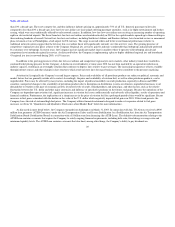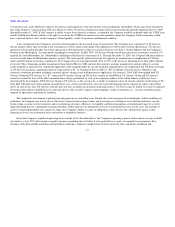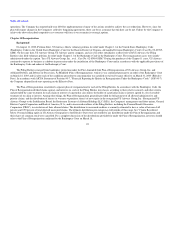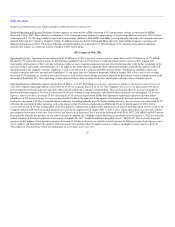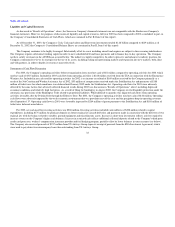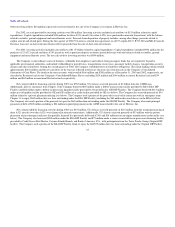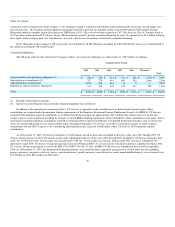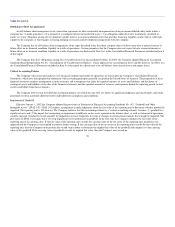US Airways 2003 Annual Report Download - page 33
Download and view the complete annual report
Please find page 33 of the 2003 US Airways annual report below. You can navigate through the pages in the report by either clicking on the pages listed below, or by using the keyword search tool below to find specific information within the annual report.
Table of Contents
(SFAS 144) on its B737-300, B737-400, B757-200 and B767-200 aircraft fleets as a result of changes to the aircraft's recoverability periods (the
planned conversion of owned aircraft to leased aircraft) as well as indications of possible material changes to the market values of these aircraft. The
analysis revealed that estimated undiscounted future cash flows generated by these aircraft were less than their carrying values for four B737-300s, 15
B737-400s, 21 B757-200s and three B767-200s. In accordance with SFAS 144, the carrying values were reduced to fair market value. This analysis
resulted in a pretax charge of $392 million. Management estimated fair market value using third-party appraisals and recent leasing transactions.
(c) During the fourth quarter of 2002, US Airways recorded a curtailment credit of $120 million related to certain postretirement benefit plans and a $30
million curtailment charge related to certain defined benefit pension plans. During the fourth quarter of 2001, US Airways recognized a $2 million
curtailment charge related to a certain postretirement benefit plan. These curtailments resulted from headcount reductions.
(d) In September 2001, US Airways announced that in connection with its reduced flight schedule it would terminate or furlough approximately 11,000
employees across all employee groups. Approximately 10,200 of the affected employees were terminated or furloughed on or prior to January 1, 2002.
Substantially all the remaining affected employees were terminated or furloughed by May 2002. US Airways' headcount reduction was largely
accomplished through involuntary terminations/furloughs. In connection with this headcount reduction, US Airways offered a voluntary leave program
to certain employee groups. Voluntary leave program participants generally received extended benefits (e.g. medical, dental, life insurance) but did not
receive any furlough pay benefit. In accordance with Emerging Issues Task Force 94-3, US Airways recorded a pretax charge of $75 million
representing the involuntary severance pay and the benefits for affected employees during the third quarter of 2001. In the fourth quarter of 2001, US
Airways recognized a $10 million charge representing the estimated costs of extended benefits for those employees who elected to take voluntary leave
and a $2 million reduction in accruals related to the involuntary severance as a result of employees electing to accept voluntary furlough. During the
quarters ended June 30, 2003 and 2002, the Company recognized $1 million and $3 million, respectively, in reductions to severance pay and benefit
accruals related to the involuntary termination or furlough of certain employees.
(e) During the third and fourth quarters of 2001, US Airways recorded charges of $4 million and $66 million, respectively, representing the present value
of the future minimum lease payments on three B737-200 aircraft and four F-100 aircraft, respectively, that were permanently removed from service.
(f) During August 2001, US Airways conducted an impairment analysis in accordance with Statement of Financial Accounting Standards No. 121
"Accounting for the Impairment of Long-Lived Assets and for Long-Lived Assets to Be Disposed Of" (SFAS 121) on its 36 F-100 aircraft, 16 MD-80
aircraft and 39 B737-200 aircraft as a result of changes to the fleet plan as well as indications of possible material changes to the market values of these
aircraft. The analysis revealed that estimated undiscounted future cash flows generated by these aircraft were less than their carrying values. In
accordance with SFAS 121, the carrying values were reduced to fair market value. This analysis resulted in a pretax charge of $403 million. In the
aftermath of September 11, 2001, the Company elected to accelerate the retirement of the aforementioned aircraft. All B737-200 aircraft retirements
were accelerated to the end of 2001 while the F-100s and MD-80s were scheduled to be retired by April 2002. Based on this, the Company conducted
another impairment analysis which revealed that these aircraft were impaired. This culminated in an additional pretax charge of $173 million largely
reflecting the further diminution in value of used aircraft arising from the events of September 11, 2001. Management estimated fair market value using
third-party appraisals, published sources and recent sales and leasing transactions. As a result of the events of September 11, 2001, the Company
reviewed other aircraft-related assets which resulted in a pretax charge of $15 million as certain aircraft assets had carrying values in excess of their fair
value less costs to sell. Management estimated fair value based on recent sales and leasing transactions. US Airways also recognized a pretax charge of
$26 million in connection with the write-down to lower of cost or market of surplus parts for the F-100, B737-200 and MD-80 fleets. Management
estimated market value based on recent sales activity related to these parts. During the first quarter of 2002, US Airways entered into agreements to sell
97 surplus aircraft and related spare engines and parts, including substantially all its DC-9, MD-80 and B737-200 aircraft. In connection with these
agreements, US Airways reduced the carrying values of these assets resulting in a $148 million charge during the fourth quarter of 2001, including a
$138 million impairment charge and a charge of $10 million to write down the related spare parts. Additionally, the
28




